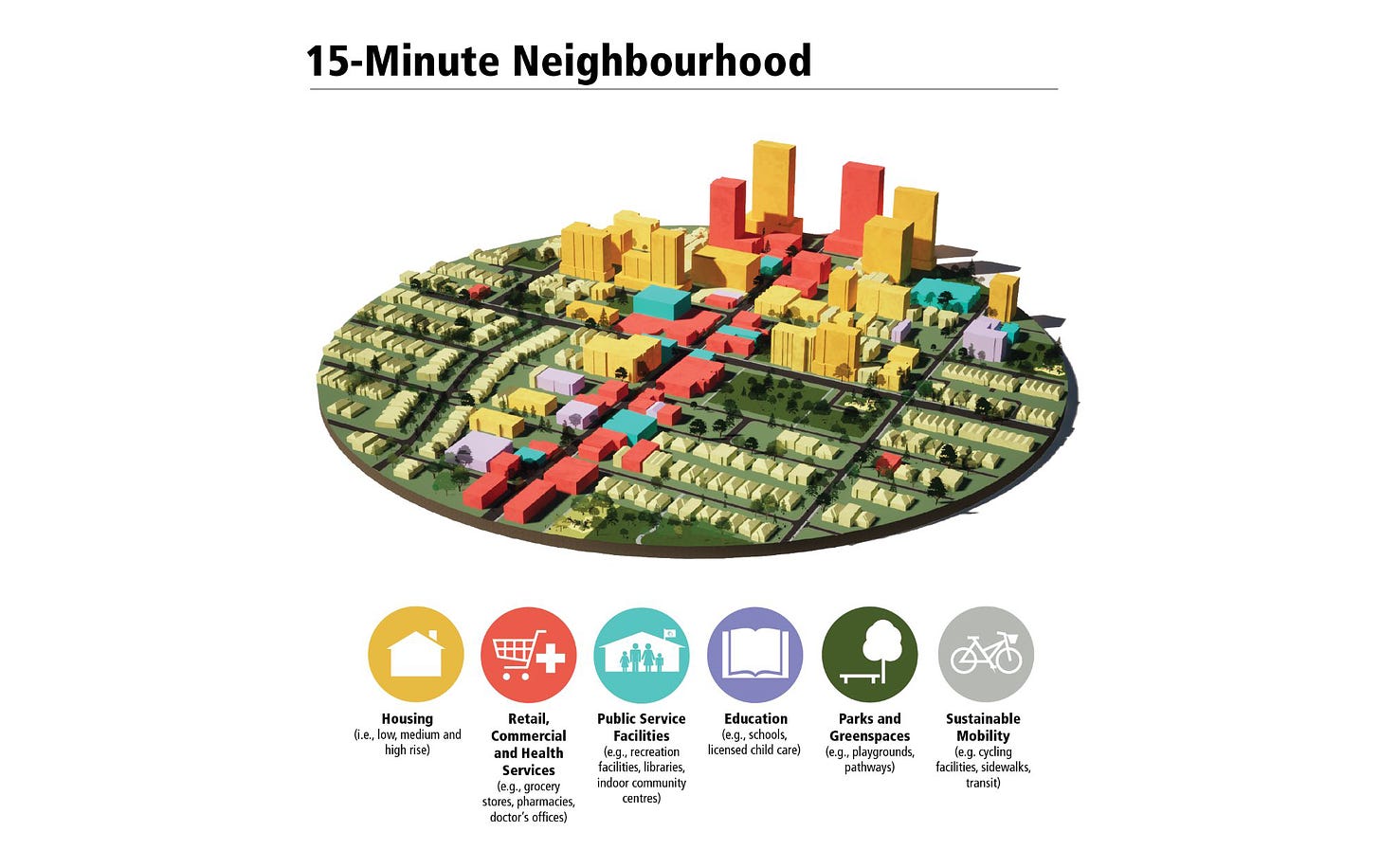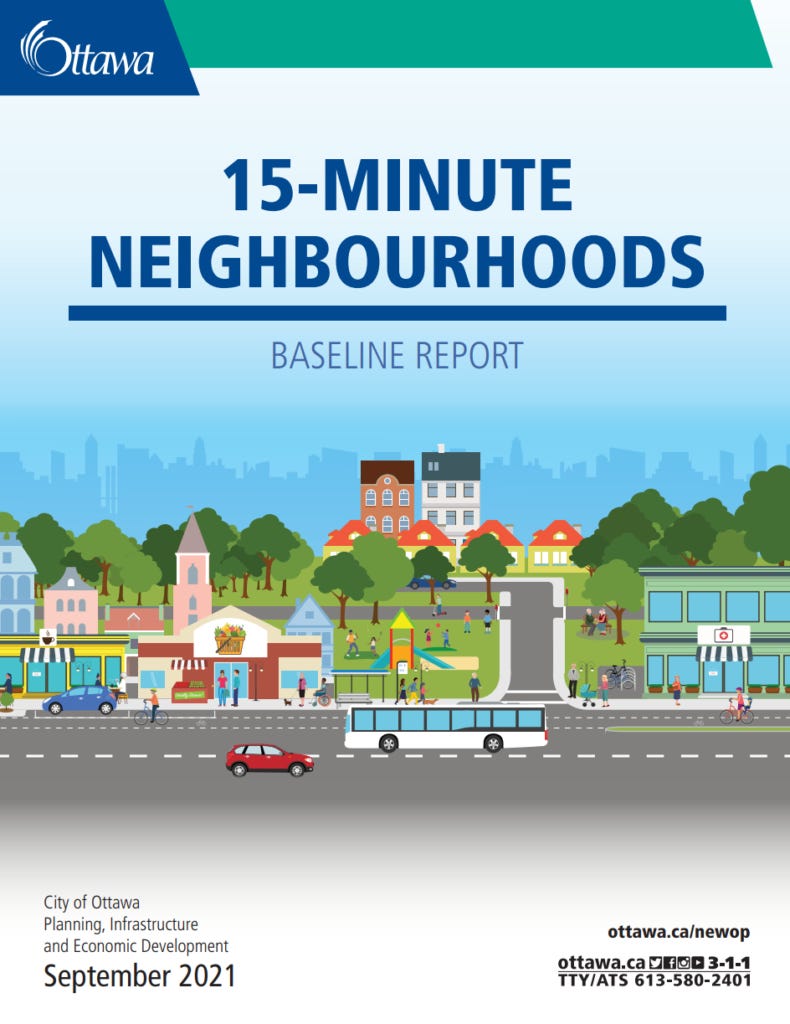PUBLIC HEALTH ENDORSES AND PLANS 15 MINUTE CITIES that has to be the biggest warning flag!!! Heads up Ottawa.
“Public Health and Planning Collaborate to Create 15-Minute City in Ottawa
Written by Kim Perrotta
Ottawa has become one of the first communities in Canada, perhaps in North America, to enshrine the 15-minute neighbourhood in its Official Plan.
“In Ottawa Public Health (OPH), our goal was to have the City’s new Official Plan built on a framework that creates communities that are healthy, inclusive, sustainable and resilient,” offers Inge Roosendaal, Healthy Communities Planner with Ottawa Public Health. “We were using our ‘Five C’s – compact, connected, convivial, complete and cool’ to describe our vision of neighbourhoods that would support these goals, but found we needed a more cohesive concept to communicate to the public and planners. So, we pitched the idea of the ‘15-minute neighbourhood’ and it resonated` with our communities.”
Process
The concept of the 15-minute neighbourhood was captured in a high-level policy directions report called the “5 Big Moves” that was approved by Ottawa City Council in September 2019 and it became a framework around which the Official Plan was built.
To meet its goals, Ottawa Public Health co-located two of its staff to the Planning Department for the three years that it took to develop the new Official Plan.
“It was seminal to the achievement of public health’s goals that public health staff were assigned to work with the Planning Department for the duration of the process. In the past, we were participants who were consulted. This time, we collaborated as fully engaged partners at every stage of the Official Plan process,” explained Inge. “This gave us the time to engage in many conversations with our colleagues in other departments. It allowed us to pull together the health evidence needed to support the policies we were promoting. We prepared one of the background papers that informed the development of the Official Plan – called “Healthy Ottawa by Design.” And we subsequently informed the discussions for the many sections the Official Plan.”
“It was actually helpful that we were engaging in this process during the COVID-19 pandemic because Ottawa residents – who were in lockdown for some of the time – were really feeling the impact that their neighbourhoods have on their lives,” noted Birgit Isernhagen, Program Planning and Evaluation Officer in Ottawa Public Health. “Those who lived in well-designed neighbourhoods could walk and cycle, access essential services, and enjoy parks and green space, while those who lived in poorly designed neighbourhoods were really feeling the effects of isolation on their physical and mental health. We started referring to the ‘15-minute neighbourhood’ as a pandemic-resilient neighbourhood and that resonated with the public.”
Outcomes
Approved by City Council in November 2021, the new Official Plan will guide development in Ottawa for the next 25 years – until 2046. It identifies five broad policy directions as “the foundation to becoming the most livable mid-sized city in North America over the next century.” Those policies articulate the need to:
Accommodate more growth by intensification of existing neighbourhoods rather than by greenfield development;
Ensure that the majority of trips in 2046 will be made by sustainable modes of transportation such as walking, cycling, transit or carpooling;
Use sophisticated urban and community design principles to create stronger, more inclusive and vibrant neighbourhoods and villages that also reflect and integrate Ottawa’s economic, racial and gender diversity;
Embed environmental, climate and health resiliency and energy into the framework of planning policies to support walkable 15-minute neighbourhoods with a diverse mix of land uses, and mature trees, greenspaces and pathways, that help the City achieve its net zero climate commitment for 2050, its 40% urban forest canopy cover target, and increase the City’s resiliency to the effects of climate change.
Embed economic development into the framework of the planning policies.
The Official Plan identifies six cross-cutting strategic policy directions that are advanced through implementation policies in multiple sections of the Plan. The Healthy and Inclusive Communities, the Climate Change and Energy, and Gender and Racial Equity policies are included in this list.
“While the broad Healthy and Inclusive Communities policies address sustainability, health equity, the need for age-friendly and inclusive communities, the cornerstone framework that pulls these elements together is the 15-minute neighbourhood” explains Inge. “We describe the 15-minute neighbourhood through policy as one that is well-connected to a diverse mix of land uses, includes a range of housing types and affordabilities, provides easy access to shops, services, schools and childcare, employment, greenspaces, parks and pathways, and is well serviced by active transportation and transit.”
“Public health staff were not responsible for developing the broad Climate Change and Energy policies, but we worked closely with our Planning colleagues to ensure that the Official Plan policies addressed the actions needed to increase community resiliency and protect the public from the impacts of the changing climate,” offered Birgit. “For example, it includes commitments to reduce the urban heat island effect, improve access to shade, preserve nature, support community gardens and food production, and enable active transportation, transit use and outdoor recreation in all weather conditions. It also notes the need to employ an equity and inclusion lens when implementing climate policies.”
Specific recommendations for these cross-cutting policies have been integrated throughout the Official Plan to ensure that the strategic goals are actually implemented. They will also be supported by other policies and plans that have been, or will be, developed by the City. For example, in September 2021, the City released a 15-Minute Neighbourhoods Baseline Report that analyses existing neighbourhoods across Ottawa against the criteria for the 15-minute neighbourhood and identifies the next steps for implementing the policy goals enshrined in the Official Plan.
All images courtesy of Ottawa Public Health.”
https://healthydesign.city/15-minute-city-ottawa/





My grandfather taught me “stay away from FREE from govt. it never is. Most usually it’s a trap. Typically they have a sinister plan but they market it as utopia for planners, owners, controllers, when, in practice, it’s dystopia for target population. Great example is the Covid-19 Grnetcs changing injectables. Advertised “effective n safe. Was not “effective and safe. Was mandatory. People crippled and death. They stonewall, they gaslight with MIs-information and dis-information. Then if you provide science you go to prison in Canada without the Charter if Rights and Freedoms. Good luck with your 15 minute cities. I chose privacy and freedom not biometric digital IF surveillance, control and punishment.
I like the carrot approach rather than the stick approach. If people want to live in a 15 minute city then fine, let them. Most cities are presently 15 minute cities with food, doctors, etc located within a 15 minute DRIVE. Many people however cannot walk more than a hundred yards. My wife is one and yesterday one of her best friends (89 yrs old) tottered out with help to see what I was up to looking at her damaged fence. We live in the countryside in Canada where there is a doctor shortage and and even greater shortage of honest doctors not pushing pills. So don't penalize people for driving to get the care they need. We saw the USA rise up against an abusive regime and Canada looks to kick out the abusive regime here within the next year. Politicians need to get the message.